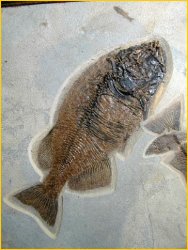Green River Formation
|
The
Green River Formation Fossil Locality - a U.S. Lagerstatten |
The
page within: Fossil Sites Also see: Green River Formation Fossil Fish Green River Formation Fossil Gallery |
|
The
Green River Formation is actually a heterogeneous complex of
lakes differential in ecological, geological characteristics,
timeframe and hence fauna and flora. The complex comprises three
primary lakes formed as a consequnce of drainage from tectonic
highlands envolved in the uplift of the Rocky Mountains during
Tertiary time. Fossil
lake, centered in Southwest Wyoming, is the smallest and appeared
briefly during the early Eocene. The Lake
While the Green River Formation is most known for its exquisite fish fossils, the fossil assemblage fully represents the entire Tree of Life, including stromatolites, plants, invertebrates and vertebrates (including reptiles, mammals and even primates). One of the most famous and exceedingly rare fossils is Icaronycteris, the oldest known flying mammal fossil. The index fossil shown in the adjacent picture was preserved with its skeleton, membranes cartilage, ingested food and waste all in situ. During the Eocene, based on the fossil record, the region was sub-tropical to temporate. Some 60 vertebrate taxa have been described from the formation, as well as abundant invertebrates and plants. Green river has been noted for its well-preserved fish since mid-way through the 19th century. The unusually excellent preservation of the Green River fish fossils is usually attributed to a combination of two factors: 1) a cold period during the Eocene that would have caused dead fish to sink faster due to a less inflated swim bladder; and 2) the great depth of the lakes and the consequent anoxic conditions that would have often prevented scavengers from disturbing the carcasses.
The
majority of fish fossils are taken from the Fossil Lake area from two layers:
1) the so-called 18-inch layer; and 2) the spilt fish layer. The best preserved
fish come from the 18-inch layer. Becuase the sediment is highly laminated, the
fish can often be removed nearly whole. This layer, in the area near Fossil Butte,
does indeed avarage about 18 inches in thickness, and represents some 4000 of
deposition. The composition of the limestone indicates that the layer was formed
in deep water far from shore. By contrast, the so-called split-fish layer is unlaminated
making extraction and preparation of the best fossil fish far more difficult.
The layer is about six feet thick, and the fauna indicates water that was better
circulated than that associated with the 18-inch layer. Some 19 genera of Eocene
fossil fish come from the Green River formation. | ||||||||||
|
Fossil
Museum Navigation:
Home Geological Time Paleobiology Geological History Tree of Life Fossil Sites Fossils Evolution Fossil Record Museum Fossils |




